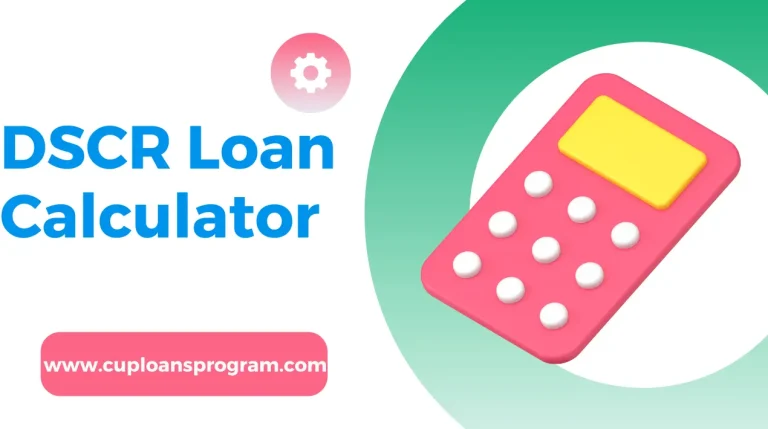DSCR Loan Requirements
DSCR Loan
30-year fixed rate DSCR loan for stabilized rental properties
| Interest Rate | from 7.5 | Term | 30-yr fixed rate |
| Origination fee | 2-3% | Maximum Loan Amount | $150,000 |
| Loan To Purchase Prices up to | 80% | Maximum Loan Amount | $3,000,000 |
| Loan To Value up to | 80% | Minimum FICO | 660 |
| Minimum DSCR | None | Type of Property | Residential 1-4 units |
What Is A DSCR Loan?
The debt service coverage ratio is based on a business’s ability to generate enough rental income in its cash flow to cover its loan repayments. It is the cash available to cover the debt that needs to be repaid.
The DSCR loan is aimed at helping real estate investors get loans for their investment properties. More cover is required, so the DSCR loan is mostly based on the DSCR ratio. The higher the ratio, the higher the risk for the lender and the better the chance of loan approval for the investor.
DSCR Loan Requirements
| Qualification | Guideline |
|---|---|
| 1. Loan-to-Value (LTV) Ratio | 75-80% |
| 2. Debt Service Coverage Ratio | ANone |
| 3. Maximum Loan Amount | $1 Million – $5 Million |
| 4. Credit Score | 680 Minimum |
| 5. Property Type and Use | Residential / Commercial |
| 6. Loan Types | Adjustable Rate / Fixed Rate |
| 7 Number of Properties Owned | No Minimum |
| 8. Prepayment Penalties | Yes (If Applicable) |
Loan-to-Value (LTV) Ratio
Real estate investors typically pay 25-23 percent of the purchase price of an investment property because lenders normally accept a loan-to-value (LTV) of 75 to 80 percent of the property’s value. Generally, the higher the down payment, the lower your monthly payment.
Debt Service Coverage Ratio
The debt service coverage ratio is a requirement for DSCR loans. This will demonstrate to lenders the exact amount of debt that can reduce the rental income of the investment property. Most lenders require a DSCR between 1.2 and 1.5. This means that the income from the property will cover the loan repayments and running costs.
Maximum Loan Amount
Typically, DSCR loans are capped at $1 million or $2 million, although some lenders may fund up to $5 million. The debt service coverage ratio of the investment property will determine the maximum loan amount the lender will offer.
Credit Score
While a borrower’s finances are not a factor in getting a DSCR loan, minimum credit standards are usually required. Lenders offering DSCR loans often require a FICO score of 680 or higher. Generally, the higher the LTV, the higher the credit score required. For example, a lender offering an 80% loan-to-value (LTV) might ask for a credit score of 700.
Property Types and Use
Investment properties with more than four units, single-family houses, multifamily complexes, commercial office spaces, hotels, and other real estate forms are eligible for DSCR loans. Properties used as investment properties to produce residential or commercial income are eligible for DSCR loans.
Loan Types
DSCR loans with fixed and adjustable rates are offered to accommodate varying borrower requirements. Depending on the lender, the loan terms could range from 30 to 40 years. Certain lenders also provide interest-only choices.
Number of Properties Owned
Most home loans limit the number of properties that can be bought with the loan; however, DSCR loans do not limit borrowers to a specific number of homes. This is because these loans are not based on personal finance but on the investment property itself. So, those using DSCR loans can purchase as many investment properties as they want.
Prepayment Penalties
If borrowers pay off a DSCR loan before the term expires, they may be subject to prepayment penalties. Since no consumer protection laws govern DSCR loans, lenders usually apply early settlement penalties to borrowers.
DSCR loan Deposit Requirements
20 – 25% (Depending On The Lender)
DSCR loans normally require a down payment of between 20% and 25% of the property’s purchase price; therefore, real estate investors should plan if they decide to apply for one. The amount of the down payment required on a DSCR loan usually depends on the LTV ratio being offered. For LTV ratios of 80%, a 20% down payment may be required.
How to Apply for the DSCR Loan Program?
Step 1: Research and Select Lender
You can search online for a lender that offers DSCR loans or ask specialists or real estate brokers for recommendations. Once a lender has been identified, review the requirements. Frequently, you’ll need to compile particular details regarding the property.
Step 2: Gather documents
The lender must then receive the pertinent documentation in the following stage. These records won’t be about your finances; instead, they will be about your business and the property, emphasizing cash flow. The investor’s financial circumstances are not a major criterion for DSCR loans, which depend on the property’s potential to generate a cash flow that will service the debt.
Step 3: Application Submission
Filling out the application form comes next after you’ve selected a lender. In addition to basic information regarding the property you plan to finance, this form will ask for information about you as the borrower. To speed up the process, ensure the information you submit is accurate.
Step 3: Preliminary Underwriting
The lender will start preliminary underwriting once they receive your application and supporting documents. They will evaluate your eligibility at this point using the data you have submitted. To ascertain whether the property is qualified for a DSCR loan, they might also do a preliminary analysis of its financial records.
Step 4: Final Verification
If the preliminary underwriting produces satisfactory findings, the lender may need to see more supporting paperwork. This could involve explaining the sources of income, providing specifics about real estate ownership, or providing any other pertinent data required to complete the loan application.
Step 5: Loan Approval and Closing
After reviewing and verifying all supporting papers, the lender will provide a loan commitment letter and a final approval. This letter outlines the authorized loan amount, interest rate, and terms of repayment, along with other important loan details.
To conclude the loan agreement, you must sign the loan documents and finish any other documentation at this point. After that, the loan will be funded, and the process of buying or refinancing real estate can proceed to the closing.
Advantages of the DSCR Loan Program
With so many advantages, the DSCR loan program is desirable for real estate investors. The following are some of the main benefits:
Streamlined Procedure
Description:
The DSCR loan program simplifies the application process by eliminating the requirement for substantial personal income evidence.
Benefit:
The time and work that would normally be spent obtaining and submitting several income verification documents might be saved by borrowers.
Higher Loan Amounts
Description:
Up to $5 million in loan amounts are available to borrowers, contingent on the type of property and lender.
Benefit:
An increased ability to borrow money gives investors more significant financial leverage when buying or investing in real estate.
Lower rates of interest
Description:
When considering other non-QM loans, such as hard money loans, DSCR loans typically have cheaper interest rates.
Benefit:
Reduced long-term borrowing expenses result from lower interest rates, which boost the investment property’s profitability.
Longer terms
Description:
DSCR loans normally have terms of five to thirty years.
Benefit:
Longer loan durations provide borrowers more freedom to arrange their monthly payments and cash flow, making them easier to handle.
Faster Closing
Description:
DSCR loans frequently close faster because they require less documentation.
Benefit:
Investors can quickly close real estate deals or take advantage of time-sensitive investment possibilities by accelerating the financing process.
Cash-Out Refinancing
Description:
Through cash-out refinancing, DSCR loans enable borrowers to take advantage of the equity in their properties.
Benefit:
Because of this flexibility, investors can use the liquidity to support various projects, including debt consolidation, home improvements, and other investment ventures.
These benefits make the DSCR loan program desirable for real estate investors who want to finance their projects with flexibility, efficiency, and favorable terms.
Disadvantages of DSCR Loans
Down payments
DSCR loans usually require down payments of 20% or more, which can be a significant amount of money to have on hand. Some investors may be discouraged because they need help to invest this much.
Cash Reserves 6 Months
Sometimes, DSCR loans that aren’t cash-out refinancing require cash reserves. Those wishing to employ DSCR loans may encounter difficulties because not all investors will have six months’ worth of financial reserves available.
LTV ratios are under 80%
For DSCR loans, the LTV ratio—the loan amount divided by the property’s appraised value—is normally between 75 and 80%. This implies that the down payment of whatever is left over will be required.
High DSCR required
A DSCR of 1.25 is regarded as satisfactory, and 1.75 or above is ideal and preferred for DSCR loans. Nevertheless, this might be challenging for investors in pricey real estate markets. Essentially, the property’s rental income must pay the debt and costs, leaving between 25% and 50% of the total. This is only sometimes feasible, and depending on the health of the local real estate market, investors can have trouble getting approved for a DSCR loan.
Higher interest rates
DSCR loans have interest rates ranging from 7% to 9%, which is significantly higher than traditional mortgages. Compared to the monthly mortgage payment on a conventional loan, this may require investors to make larger monthly loan payments and pay more for a DSCR loan overall.







